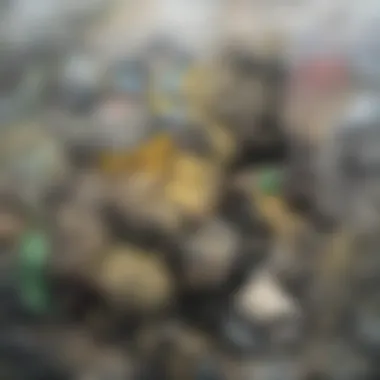Understanding the Microplastic Crisis: Causes and Solutions


Intro
Microplastics have recently gained attention as a critical environmental issue. These small plastic particles, less than five millimeters in size, originate from various sources, including the degradation of larger plastic items and the shedding of synthetic fibers from clothing. The journey of microplastics through ecosystems raises significant concerns, as they infiltrate our oceans, rivers, and even the air we breathe.
Although research on microplastics is ongoing, it becomes increasingly clear that their implications extend beyond environmental degradation. Studies indicate that these particles do not simply persist in nature; they can also accumulate within food webs, ultimately impacting human health as well. This article seeks to illuminate the multifaceted aspects of the microplastic problem, shedding light on its sources, pathways, and implications for wildlife and human beings alike.
As we delve into the various dimensions of this pressing issue, it is essential to highlight recent advances in research and the methodologies adopted for studying microplastics. An understanding of these elements is integral for motivating effective responses and solutions.
Foreword to Microplastics
The significance of microplastics in today’s environmental discourse cannot be overstated. Microplastics are small plastic particles less than five millimeters in size, and they have become a pervasive pollutant in various ecosystems. The increasing presence of microplastics in our surroundings impacts not only wildlife but also human health. Understanding their origins, behavior, and effects is crucial for developing effective solutions and mitigating their impact.
Microplastics arise from numerous sources. They can originate as primary microplastics, designed specifically for products, or as secondary microplastics, generated through the degradation of larger plastic items. The importance of identifying these sources and pathways helps in crafting targeted policies and informing the public. Affordable means of addressing the problem can lead to significant positive outcomes.
Definition of Microplastics
Microplastics are defined as plastic pieces that measure less than five millimeters in diameter. These particles can be categorised into two main types: primary and secondary. Primary microplastics are manufactured at this smaller size for use in items such as cosmetics and industrial applications. Secondary microplastics, on the other hand, are the result of larger plastic items breaking down into smaller fragments through processes like weathering, abrasion, and photodegradation.
This distinction is vital for understanding how microplastics infiltrate the environment. Primary microplastics can enter water systems directly, while secondary microplastics can accumulate over time in terrestrial and aquatic settings as larger plastic objects disintegrate. This knowledge aids in recognizing their pathways, which is essential for environmental management strategies.
Historical Context
The presence of plastics in our environment is not a contemporary issue. The production of plastics began in the early 20th century, and over the decades, it has surged to the point where it is now ubiquitous. The convenience and versatility of plastic materials drove widespread adoption in many applications.
In the 1970s, scientific literature first addressed the impact of plastic waste, marking the beginning of environmental awareness regarding this issue. As research progressed, the identification of microplastics became clearer by the late 20th century. Today, various studies illustrate how microplastics have infiltrated oceans, rivers, and even remote landscapes. Their persistence in the environment raises alarms, highlighting a pressing need for remediation and action.
Addressing the historical context establishes a need for urgent change in consumption habits and waste management practices. Without acknowledgement of our past and present practices, it may be challenging to develop effective strategies to combat the growing microplastic pollution crisis.
"Microplastics are not just a modern conundrum; they are a result of our evolving relationship with plastic materials. Understanding the journey of plastics from production to pollution will shape our response to this pressing issue."
Understanding the intricate relationship between microplastics and the environment aids in recognizing their far-reaching implications. This groundwork sets the stage for exploring the extensive effects microplastics impose on our planet.
Sources of Microplastics
Understanding the sources of microplastics is crucial for addressing their pervasiveness in the environment. Microplastics originate from various activities and processes that segment into primary and secondary sources. These sources contribute significantly to the problem, affecting ecosystems and human health. By examining these origins, we can better formulate strategies for prevention and mitigation.
Primary Sources
Primary microplastics are those intentionally manufactured to be small in size. Common examples include microbeads found in cosmetics and personal care products. Items like facial scrubs and toothpastes often contain these additives. They are washed down the drain, entering water systems and, ultimately, the ocean. This cleaning process leads to millions of tons polluting the water, affecting marine life.
Another significant contributor is industrial abrasives. They are used in processes like sandblasting. Such use continually send small plastic particles into the environment. This sector needs stricter regulations to limit this practice.
In the fiber industry, strong focus on synthetic fibers like polyester or nylon contributes notably. When washed, these fabrics release microfibers that permeate rivers and lakes. Studies suggest that every load of laundry can release thousands of these microfibers, which will join the aquatic ecosystem, complicating the already problematic scenario of microplastic pollution.
Secondary Sources
Secondary microplastics arise from the degradation of larger plastic debris. Over time, exposure to sunlight, wave action, and physical forces break down plastics. This process creates smaller particles that are harmful yet often go unnoticed. An example is plastic bottles, bags, or discarded fishing nets. Their breakdown contributes significantly to the total microplastic content in oceans, lakes, and even soils.
Urban runoff is another vital contributor. Roads and drainage systems collect plastic debris and wash it into nearby bodies of water. Due to rain and wind, debris can be transported far, leading to a spread of secondary microplastics. This interconnectedness signifies the immediate need for awareness and actions to prevent plastic waste from reaching the environment.
Industrial Contributions
Industries playing a role in microplastic production require scrutiny. Manufacturing processes in various sectors release microplastics, either directly or indirectly. Pulp and paper industries, for example, might use microplastic additives in their products. Their unregulated discharge leads to polluted waterways, which can harm marine life and enter the food chain.
Additionally, the construction sector produces microplastics through building materials. Items like paints, sealants, and some insulation materials may release microplastics into the environment during application or weathering. There's a gap in awareness here, as companies rarely consider the consequences of these practices on environmental health.
"Microplastics, once thought merely nuisance pollution, now represent critical threats to both ecosystems and human health."
Pathways of Microplastics in the Environment
Microplastics, small plastic particles less than five millimeters in diameter, have intricate pathways through which they enter and disperse within the environment. Understanding these pathways is essential for identifying the sources of pollution and devising effective remediation strategies. Microplastics can originate from various activities and products, permeating ecosystems and even entering food chains. As they travel through the environment, the mechanisms of their transport and the areas where they accumulate become critical in assessing their ecological impact.
Transport Mechanisms
Transport mechanisms of microplastics include a range of processes that facilitate their movement in various environmental media. These mechanisms may operate across air, water, and soil, illustrating the pervasive nature of microplastic pollution. Wind can carry airborne microplastics over long distances, while water bodies can transport these particles through currents and tides in rivers, lakes, and oceans.
Factors influencing transport include:
- Physical Properties: Size, shape, and density of microplastics impact their buoyancy and movement. Lighter fragments can remain suspended in water or be easily lifted by wind.
- Environmental Dynamics: Ocean currents and freshwater runoff play a significant role in distributing microplastics. Seasonal changes or weather events can alter the flow patterns, affecting where microplastics accumulate.
- Sediment Interaction: Microplastics can adsorb to organic and inorganic materials, influencing their settling behavior in aquatic environments. When microplastics bind to sediments, they can either accumulate in riverbeds or be resuspended into the water column.
These transport mechanisms ultimately reveal the multifaceted nature of how microplastics are distributed in ecosystems, and knowing this can help in targeting cleanup efforts effectively.
Accumulation Zones
Accumulation zones refer to specific areas where microplastics aggregate, often due to environmental features or human activity. Recognizing these zones is critical in understanding the environmental burden of microplastics. Some of the notable accumulation sites include:
- Ocean Gyres: Large systems of rotating ocean currents, such as the Great Pacific Garbage Patch, are notorious for accumulating floating plastics, including microplastics.
- River Mouths: Areas where rivers meet the sea often act as funnels, collecting microplastics that have traveled downstream.
- Coastal Areas: Shorelines can trap microplastics washed ashore during storm events or high tides, leading to significant concentrations along beaches.
- Urban Runoff: Areas with high population density can contribute to microplastic accumulation in stormwater systems, where microplastics from roads or waste can converge.
Understanding these zones aids researchers and policy-makers in targeting interventions for microplastic pollution. Monitoring these areas facilitates comprehensive data collection to assess ecological consequences as well.
"Microplastics have a vast range in their pathways, and understanding where they accumulate is key to managing their impact."
In summary, the pathways of microplastics in the environment reveal complex interaction patterns driven by both natural and anthropogenic processes. Investigating the transport mechanisms and accumulation zones enhances our understanding of this pollution crisis and enables the development of more effective strategies for reducing and managing microplastic contamination.
Environmental Impact of Microplastics
The environmental impact of microplastics is a critical focus in understanding their implications. These small plastic particles have infiltrated various ecosystems, significantly altering natural balances. As they accumulate, they pose threats not only to wildlife but also to broader ecological systems and human health. Addressing these impacts requires a thorough examination of specific interactions within different environments, as well as how microplastics enter food chains and other biological contexts.
Effects on Marine Life
Marine ecosystems are severely affected by the presence of microplastics. Fish, seabirds, and marine mammals often ingest these particles, mistaking them for food. This ingestion can lead to physical harm, blockages, and reduced nutritional intake, affecting overall health and survival rates. Research indicates that ingestion of microplastics may result in reproductive issues and altered growth patterns in marine life. For instance, studies have shown that species like Mahi-Mahi and Oysters are increasingly found with microplastics in their systems.
Additionally, microplastics can act as carriers for harmful chemicals and pathogens. When marine organisms consume these particles, they may also absorb contaminants like heavy metals and persistent organic pollutants. This phenomenon poses a risk not only to marine creatures but also to humans who consume seafood.
Impact on Terrestrial Ecosystems


Microplastics also infiltrate terrestrial ecosystems, albeit through different pathways. They can enter soils via agricultural practices and wastewater treatment outputs. In soil, microplastics may affect microorganisms, which are vital to nutrient cycling and soil health. Their presence can disrupt microbial functions, potentially impacting plant health and productivity. Some plants may take up microplastics through their root systems, embedding them within the food chain.
Moreover, terrestrial animals may ingest microplastics inadvertently or intentionally. Research has suggested that impacts on soil-dwelling creatures, such as earthworms, could lead to alterations in soil structure and fertility. This presents a profound concern for agriculture and natural habitats alike.
"Microplastics are not just an oceanic menace; they are quietly permeating terrestrial ecosystems and endangering a multitude of species and food sources."
Human Health Implications
Understanding the human health implications of microplastics is crucial. This issue is not just about environmental sustainability but extends deeply into human health and well-being. Since microplastics are present in the air, water, and food, their potential impact on humans necessitates thorough examination. When people consume contaminated food or drink water with microplastic particles, these pollutants can enter the body. Little is known about what happens once they are inside. The concern is that these tiny particles can disrupt bodily processes.
Exposure Pathways
Microplastics can enter the human body through several pathways:
- Ingestion: This is the most common route. Microplastics are prevalent in seafood, bottled water, and even in the salt we consume. As a result, our daily diet may unknowingly carry these plastic particles.
- Inhalation: Tiny plastic fibers can also become airborne. Research shows that these particles can be inhaled into the lungs, which poses additional health risks.
- Dermal Absorption: Though less documented, certain cosmetic products may contain microbeads. When these products are applied to the skin, there is potential for absorption.
- Translocation: Once in the body, microplastics may be able to migrate to different tissues, raising questions about their long-term effects.
In summary, these pathways highlight how commonplace microplastics are in our environment and diet. Awareness about these routes is essential as they may pose unseen risks to health.
Potential Health Risks
The potential health risks associated with microplastics are still an area of active research. Preliminary findings suggest several concerns:
- Inflammatory Responses: Initial studies indicate that microplastics can provoke inflammation. This reaction could lead to chronic health issues over time.
- Chemical Leaching: Microplastics can attract and absorb toxic chemicals from their surroundings. When ingested, these harmful substances may enter the human body, causing various health issues.
- Endocrine Disruption: Some microplastics contain additives that mimic hormones. These chemicals can interfere with hormonal balance, potentially leading to reproductive health issues.
- Bacterial Attachment: Research highlights the possibility of harmful bacteria adhering to microplastics. This could pose additional health risks if these bacteria enter the human system.
It is clear that understanding microplastics is important not only for ecological reasons but also for protecting human health.
Microplastics in Food Chains
Microplastics have become a prominent concern, especially when considering their presence in food chains. This issue is crucial because it highlights the interconnectivity of ecosystems and the potential impact on human health. Understanding how microplastics enter food chains can help develop strategies to mitigate their effects.
Bioaccumulation and Biomagnification
Bioaccumulation refers to the process by which organisms absorb substances faster than they can eliminate them. In the case of microplastics, smaller organisms such as plankton ingest these particles. As these organisms move up the food chain, larger predators consume them. This leads to biomagnification, where the concentration of microplastics increases at each trophic level.
- Species at Risk: Fish and shellfish often have high levels of microplastics. They can accumulate toxins that adhere to plastic particles, potentially leading to health risks in humans who consume seafood.
- Ecosystem Dynamics: The presence of microplastics alters food web structures, affecting predator-prey relationships.
The implications of these processes are profound. If larger fish ingest microplastics, it can affect their growth, reproduction, and overall health. Over time, these animals can show reduced populations due to decreased health and habitat viability.
"Microplastics potentially pose a hidden threat not only to wildlife but also to global food security as they enter the human food system."
Case Studies
Multiple case studies illustrate the impact of microplastics in food chains across different species and regions.
- The Great Lakes: In this freshwater system, studies have shown microplastics present in the stomachs of fish species, indicating they are being ingested and potentially entering the human food supply.
- The Mediterranean Sea: Research has found microplastics in fish commonly consumed by local populations. This raises concerns about human exposure to these pollutants.
These case studies demonstrate that the issue is not confined to less developed regions. Even well-regulated environments face the risk of microplastic contamination.
Examining these impacts helps to inform local and global policies. Understanding the pathways of transfer within food chains can lead to better regulatory measures, potentially reducing microplastic pollution and its effects on health.
Policy and Regulation Responses
Addressing the microplastic issue necessitates a robust framework of policies and regulations. Legal measures play a critical role in managing the sources and effects of microplastics. They can enforce accountability, promote innovation, and encourage sustainable practices among corporations and individuals alike.
Policies targeting microplastics must be multidimensional. They should not only focus on regulating emissions but also on enhancing research and public awareness. Legislators have the responsibility to balance economic growth with environmental protections. This can lead to cleaner waterways, safer food sources, and ultimately better public health.
Effective policy can serve as a catalyst for necessary changes at several levels.
Current Legislation
Numerous countries have begun to appreciate the urgency of microplastics within their legislative frameworks. Key pieces of legislation include bans on specific types of single-use plastics, incentives for recycling, and penalties for pollution. In Europe, the European Union's Single-Use Plastics Directive aims to significantly reduce plastic waste by encouraging member states to impose restrictions.
In the United States, the Microbead-Free Waters Act prohibits the sale of rinse-off cosmetic products containing microbeads. Environmental agencies also focus on assessing and limiting plastic waste in waterways. Countries such as Canada and Australia are exploring similar legal structures to mitigate the effects of plastic pollution.
Global Initiatives
Several global initiatives are instrumental in combating the microplastic crisis. Organizations like the United Nations have initiated collective actions to address plastic pollution through multilateral agreements. The "Global Partnership on Marine Litter" encourages collaboration among countries for sharing research and best practices related to waste management.
There are also notable non-governmental organizations such as the Plastic Pollution Coalition that promote awareness and advocate for sustainable practices. Support for initiatives like "Clean Seas" campaign and other grassroots movements highlights the significance of reducing plastic use on a larger scale.
Remediation Technologies
The topic of remediation technologies is crucial in the context of microplastics. As the scale of microplastic pollution continues to grow, developing effective methods for removal and mitigation becomes essential. These technologies aim to reduce the presence of microplastics in various environments, including marine and terrestrial ecosystems. The need for remediation arises from the pervasive nature of microplastics, which have been detected in the deepest ocean trenches, remote Arctic regions, and even in drinking water. Addressing this issue is not only about cleaning up existing pollutants, but it also involves implementing strategies that prevent further contamination.
Effective remediation technologies can provide multiple benefits:
- Environmental Restoration: Technologies used for remediation help restore ecosystems impacted by microplastics, promoting biodiversity and ecosystem health.
- Public Health Protection: By reducing microplastics in food chains and water supplies, these technologies can mitigate potential health risks associated with human exposure.
- Economic Benefits: Clean environments enhance recreational areas and fisheries, supporting local economies reliant on tourism and fishing.
Physical Phase Separation
Physical phase separation is one of the prominent remediation technologies. This process involves the separation of microplastics from other materials in the environment, utilizing methods based on physical differences such as size, density, and buoyancy. Techniques like sieving, flotation, and air classification are examples of this approach.
This method holds certain advantages:
- Simplicity: Physical methods are often straightforward and can be designed for various environments, such as oceans or rivers.
- Immediate Results: These techniques can provide prompt results in terms of removing visible plastic debris, offering an immediate visual improvement in affected areas.
However, there are also considerations to keep in mind:
- Incomplete Removal: Some microplastics may remain in the environment, especially those that are smaller than the size limits of separation techniques.
- Ecosystem Impact: The process itself may disturb local habitats, necessitating careful planning and implementation to minimize ecological footprints.
Bioremediation Strategies
Bioremediation offers a biological approach to addressing microplastic pollution. This strategy leverages microorganisms, such as bacteria, fungi, and algae, to break down or absorb microplastics. Some species have shown the potential to degrade certain types of plastics, converting them into less harmful substances.
This method can provide notable benefits:


- Sustainability: Bioremediation is often more environmentally friendly than physical methods, as it utilizes natural processes to address pollution.
- Long-term Solutions: By encouraging natural degradation processes, bioremediation can potentially offer lasting solutions to microplastic contamination.
However, bioremediation also faces certain challenges:
- Limited Application: Not all plastics are easily degradable by biological means, which limits the effectiveness of this strategy.
- Time-Consuming: The biological processes can take longer than physical methods, delaying immediate visible results.
Overall, integrating diverse remediation technologies are vital to effectively tackle the microplastic problem. The best approach may likely involve a combination of methods tailored to specific environmental contexts.
Each of these remediation strategies - physical phase separation and bioremediation - presents unique advantages and challenges. Ongoing research and innovation are essential to enhance the efficiency and effectiveness of these methods in reducing microplastic pollution.
Public Awareness and Education
Public awareness and education play a crucial role in addressing the microplastic problem. Without a well-informed public, it is difficult to garner support for effective policies and necessary changes in individual behavior. Awareness initiatives can bridge the gap between scientific research and everyday actions. Furthermore, when people understand the implications of microplastics, they are more likely to engage in sustainable practices that mitigate the problem.
Key elements in building public awareness about microplastics include effective communication strategies that emphasize the environmental and health risks associated with microplastic pollution. Organizations and advocates often launch campaigns to educate the public about sources of microplastics and their impacts—the goal being to inspire motivated responses. Another important consideration is how to tailor messages for different audiences. For example, campaigns aimed at children may need playful visuals and simple language, while efforts directed at adults can utilize data and case studies.
The benefits of heightened public awareness are manifold:
- Informed Consumer Choices: People who understand microplastics are more likely to choose products that minimize plastic use.
- Support for Policies: Advocacy for stricter regulations becomes more powerful when the general public is knowledgeable about the issue.
- Community Engagement: Programs aimed at reducing plastic waste often see better participation when community members are aware of the stakes.
"Public education does not only inform; it also empowers people to take action in their communities."
Overall, public awareness and education are fundamental to creating a culture that values sustainable interactions with the environment, thus contributing to long-term solutions to the microplastic issue.
Campaigns and Advocacy
Campaigns and advocacy are essential components of public awareness about microplastics. In recent years, various organizations have initiated campaigns targeting different aspects of the microplastic crisis. These campaigns typically aim to educate, engage, and mobilize the public.
One effective strategy has been the use of social media platforms. Campaigns on Instagram or Facebook often utilize visually appealing graphics and concise messages to grab attention. Some notable campaigns focus on:
- Plastic Free July: A global initiative encouraging individuals to refuse single-use plastics during the month of July.
- #BeatPlasticPollution: This campaign encourages individuals and organizations to take actions that reduce plastic pollution, often garnering significant online attention.
Such efforts can lead to significant societal shifts. When enough individuals rally behind a cause, larger systemic changes in industries can follow.
Role of Education Systems
Education systems hold a significant responsibility in shaping future generations' understanding of environmental issues, including microplastics. Schools and universities can incorporate modules on microplastics into science curricula to raise awareness from a young age.
Some ways education systems can contribute include:
- Curriculum Development: Integrating lessons on plastic pollution, its effects, and mitigation strategies helps students understand the science behind the macro issue of microplastics.
- Practical Projects: Schools can engage students in local clean-up efforts or projects analyzing local water sources for microplastics, which fosters hands-on learning.
- Partnerships with NGOs: Collaborating with environmental organizations can provide students with resources and real-world applications of their studies.
In summary, education systems have the potential to significantly influence public perception and response to the microplastic crisis. By embedding sustainability into education, societies can prepare informed citizens equipped to tackle this pressing issue.
Future Research Directions
Future research directions related to microplastics remain crucial for developing effective solutions to this widespread issue. Understanding the implications of these tiny particles requires continuous exploration in various scientific fields. Furthermore, the industry’s need to innovate solutions cannot be overstated. There is an emergent requirement for comprehensive studies addressing microplastic behavior in diverse environments, toxicity assessments for wildlife and humans, and methods to effectively remediate affected areas.
Research should pay special attention to long-term monitoring to evaluate the persistent presence of microplastics in ecosystems. This allows for understanding and forecasting potential ramifications throughout the food chain and establishing a clearer connection between microplastic pollution and health impacts on living organisms. As the problem grows, the ability to generate reliable data will help policymakers make informed decisions.
Innovative Approaches
Innovative approaches are imperative for tackling the microplastic challenge. Researchers are exploring advanced technologies like machine learning and artificial intelligence to identify and classify microplastics in environmental samples. These technologies can analyze vast amounts of data, revealing patterns that traditional methods might overlook. Such innovations promise enhanced detection capabilities, leading to better strategies for containment and removal.
Additionally, there are ongoing developments in alternative materials that are biodegradable. For instance, scientists are examining natural polymers that could replace conventional plastic. These materials might break down more effectively without leaving harmful residues.
Research must also investigate the optimization of existing recycling processes, ensuring that plastic is reused as much as possible. Improved sorting technologies can enhance recovery rates, thus reducing the volume of microplastics entering the environment.
Interdisciplinary Studies
Interdisciplinary studies involving environmental science, chemistry, biology, and social sciences are essential for a holistic understanding of microplastics. Different disciplines contribute unique perspectives and methodologies, enriching the research landscape. For instance, biologists can study the effects of microplastics on marine organisms while chemists can analyze their material composition. This combined knowledge can lead to more effective policies.
Moreover, engaging social scientists can help address human behaviors contributing to plastic pollution. By understanding how policies or education can influence consumer habits, researchers can propose solutions that target the root causes of microplastic production.
Ultimately, interdisciplinary research fosters collaboration, essential for addressing a multifaceted issue like microplastics. Sharing insights across fields can cultivate innovative solutions, ensuring that all angles of the problem are analyzed and understood.
Sustainable Practices to Reduce Microplastics
Addressing the microplastic issue demands a multi-faceted approach, with sustainable practices taking center stage. Sustainable practices involve strategies and habits that minimize the production and release of microplastics into the environment. These practices are vital not only to mitigate the ongoing effects of microplastics on ecosystems but also to reshape consumer behaviors and corporate policies that contribute to this problem.
Implementing sustainable practices offers several benefits. It provides a way to preserve ecological balance and protects biodiversity. Moreover, it encourages communities and businesses to adopt a more responsible stance towards consumption and waste management, fostering a collective movement towards a cleaner planet.
Individual Actions
Every individual can play a crucial role in reducing microplastics. Simple decisions can have a significant impact. People can start by making mindful choices in their daily lives. Here are some specific actions to consider:
- Reduce Single-Use Plastics: Avoid plastic bags, straws, and bottles. Opt for reusable alternatives instead.
- Choose Natural Fibers: When buying clothing, select materials like cotton or wool. Synthetic fibers can release microplastics during washing.
- Support Filtering Solutions: Use washing machine filters designed to capture microfibers before they reach water systems.
- Participate in Clean-Up Drives: Actively engage in local efforts to remove plastic waste from your community, helping prevent it from breaking down into microplastics.
These actions, though small in isolation, contribute to a larger societal shift towards sustainable practices that curtail the production and spread of microplastics.
Corporate Responsibility
Corporations have a significant impact on the microplastics problem, as their production processes often contribute heavily to waste generation. Acknowledging this responsibility is essential for sustainable development. Companies can adopt various strategies to minimize microplastics:
- Investing in Research and Development: Explore ways to create alternative materials that are biodegradable or sustainable.
- Implementing Sustainable Packaging: Shift towards materials that do not contribute to plastic pollution, thereby leading the change in product development.
- Engaging in Transparency: Being open about the usage of plastics in products and their potential environmental impacts fosters trust and encourages consumer awareness.
- Collaborating with Non-Profits: Joining forces with NGOs focused on environmental protection can amplify efforts towards reducing plastic waste.
These corporate strategies not only help in reducing microplastic pollution but also enhance brand reputation and customer loyalty. By taking responsibility, companies can be part of the solution, influencing future generations positively.
"Sustainable practices require commitment at all levels—individuals, businesses, and governments—to truly counter the microplastics crisis we face today."
Case Studies and Success Stories
Understanding the practical implications of microplastics requires examining case studies and successful interventions. These narratives provide tangible evidence of strategies that can effectively address the microplastic crisis. By focusing on specific incidents and initiatives, we can analyze what worked, what did not, and how these lessons can be adapted elsewhere. Such insights help translate theory into action, showing the possibility of measurable improvements in environmental health and community engagement.
"Real-world examples illuminate the path toward effective solutions to the microplastic problem."


Community Initiatives
Community initiatives play a significant role in combating microplastic pollution. Local groups often serve as grassroots movements driving awareness and action. They mobilize volunteers to conduct clean-up operations along coastlines and waterways.
For instance, The Ocean Conservancy organizes the International Coastal Cleanup, where volunteers collect data on litter, including microplastics. This data is crucial to understanding the sources and trends of litter in various regions. Such community-driven actions do not only remove physical waste but also foster a sense of responsibility and connection to the environment. Initiatives like these demonstrate how collective efforts can foster more sustainable practices at the local level.
In addition, educational programs focused on the effects of microplastics can inspire behavioral change. When communities learn about the impacts of their plastic consumption, they are more likely to adopt practices that reduce waste. Here are some examples of successful community initiatives:
- Organized workshops on reducing plastic use.
- Engagement in local policy-making discussions to encourage more stringent regulations.
- Promotion of recycling programs that specifically target microplastic alternatives.
Successful Policy Interventions
Effective policy interventions are critical for managing microplastic pollution at larger scales. Governments and organizations that initiate legislative actions demonstrate the potential to mitigate this issue effectively. Policies can include bans on single-use plastics, regulations on industrial discharges, and incentives for using biodegradable materials.
For example, European Union's Single-Use Plastics Directive outlines measures to reduce waste from specific plastic products. This directive aims to foster innovative alternatives while also raising public awareness about the need for sustainable consumption.
Another noteworthy intervention came from California, which enacted strict regulations on microbeads in personal care products. As a result, significant reductions in microplastic contamination in aquatic environments were reported. This case highlights the effectiveness of targeted legislation in addressing specific pollution sources.
When evaluating successful policy interventions, consider:
- Clear objectives that address specific problems.
- Collaboration between governmental and non-governmental organizations for broader reach.
- Involvement of industry stakeholders to support transition towards sustainable alternatives.
Community initiatives and policy interventions are essential paths toward mitigating microplastics and offer valuable frameworks for future efforts.
Technological Innovations in Monitoring
Technological innovations in monitoring microplastics are crucial for understanding the extent and impact of this environmental issue. These advancements assist researchers and policymakers in detecting and quantifying microplastics in various ecosystems. Enhanced monitoring methods provide data that inform remediation efforts and track the efficacy of regulations aimed at reducing microplastic pollution. The integration of technology in this field allows for more precise measurements and better insights into the behavior of microplastics in the environment.
One of the significant benefits of these innovations is the ability to identify microplastics at smaller scales than ever before. Traditional methods of detection often missed smaller particles, which are now acknowledged as detrimental. Technologies such as advanced spectroscopic techniques and automated microscopy have transformed the ability to detect diverse microplastic types, thus amplifying our understanding of their sources and pathways.
Additionally, modern monitoring technologies facilitate real-time data collection, enabling swift responses to emerging microplastic issues. Continuous monitoring can reveal trends and patterns, critical for scientific research and educational purposes. Understanding this data can drive policy changes and public awareness campaigns, aligning community efforts against microplastic pollution.
Detection Methods
Detection methods for microplastics have advanced significantly over recent years. One notable technique is Raman spectroscopy, which allows for the analysis of microplastic samples at a molecular level. This method helps differentiate between various types of plastics, thus identifying their origins more accurately. Another significant method is Fourier-transform infrared spectroscopy (FTIR), which similarly provides detailed characterization of microplastics and is widely used in laboratories.
Research also involves the use of imaging techniques, such as scanning electron microscopy (SEM). SEM offers high-resolution images, allowing scientists to see the morphology and size of microplastic particles. These methods combined provide a robust toolkit for researchers to better understand the microplastic problem from various perspectives.
Data Collection Approaches
Data collection approaches are vital for comprehensively monitoring microplastics and involve multiple strategies to gather relevant information. Field sampling remains an essential practice, as it provides real-world insights into microplastic distribution across different environments. Samples can be collected from water bodies, sediments, and even atmospheric samples, depending on the research focus.
Another data collection strategy includes citizen science initiatives. Engaging local communities in monitoring activities can enhance data quality and quantity while raising awareness about microplastic pollution. Volunteers can collect samples from local beaches or rivers, providing researchers with valuable data while empowering the public to participate in environmental protection.
Moreover, remote sensing technologies are emerging as effective tools for data collection. These techniques can help track and model microplastic pollution on a larger scale, allowing for comprehensive assessments of pollution hotspots. Leveraging a mix of traditional sampling and innovative technologies creates a more holistic understanding of microplastics in the environment, aiding in preventative strategies and targeted regulation.
"Monitoring technologies not only aid in detection but also pave the way for impactful solutions to combat microplastic pollution."
In summary, technological innovations in monitoring microplastics are essential for informed decision-making and effective policy development. As detection methods and data collection approaches continue to improve, the insights gained will undoubtedly play a critical role in addressing this urgent environmental concern.
Consumer Choices and Microplastics
In the realm of microplastics, individual consumer choices play a pivotal role in shaping environmental outcomes. Recognizing this link is essential for addressing the microplastic problem effectively. Consumers wield significant power through their purchasing habits, impacting the demand for products that contribute to microplastic pollution. This section will delve into two critical aspects: product awareness and the shift towards alternatives.
Product Awareness
Product awareness is crucial in the fight against microplastics. Many consumers are unaware of the microplastic content in everyday items, such as personal care products and synthetic textiles. Items like exfoliating scrubs often contain plastic microbeads, which wash off during use and eventually enter waterways. Similarly, washing synthetic clothes can release tiny fibers into the wash water, further contributing to the microplastic crisis.
To combat this issue, consumers need to be informed about the products they purchase. Awareness can stem from educational initiatives, public campaigns, and detailed product labeling. By understanding product compositions, consumers can make informed choices that minimize microplastic consumption. Shifting towards brands that emphasize transparency and sustainability helps reduce the environmental footprint associated with plastic pollution.
Shift Towards Alternatives
Shifting towards alternatives is a necessary strategy for reducing microplastic pollution. As consumer awareness grows, so too does the availability of eco-friendly products. There are numerous options that fulfill similar purposes without contributing to the microplastic problem. For example, consumers can choose natural exfoliants such as sugar or salt instead of microbead-containing scrubs. Furthermore, selecting clothing made from organic cotton, hemp, or other natural fibers can significantly decrease the release of microplastics into the environment.
Additionally, being proactive in supporting companies focused on reducing plastic usage is vital. Brands like Patagonia and Ecover are examples of companies making strides toward sustainability by offering alternatives to traditional products. Moreover, eco-conscious consumers can advocate for policy changes that promote the use of biodegradable materials. Communities can cultivate a market environment that favors sustainable practices.
"Consumer behavior can drive meaningful changes in the fight against microplastics, reflecting a strong market demand for sustainability."
International Collaboration Efforts
International collaboration is essential in addressing the microplastic problem. This issue knows no borders, as microplastics can easily travel across geographical and political boundaries through waterways, oceans, and atmospheric currents. Without coordinated global efforts, individual countries may struggle to tackle the complexity and scale of microplastic pollution. Key benefits of international collaboration include sharing of knowledge, pooling of resources, and harmonization of policies, all of which are crucial to creating effective solutions.
Transboundary Policies
Transboundary policies refer to agreements or frameworks that countries establish to manage shared environmental concerns. In the case of microplastics, these policies can facilitate cross-border cooperation in monitoring, controlling, and mitigating pollution. Countries can work together to set standards for allowable levels of microplastics in aquatic environments, ensuring that pollution control measures are equitable and effective.
Some existing transboundary policies relevant to microplastics include the Basel Convention, which governs the movement of hazardous waste between nations, and various marine treaties addressing pollution control in shared waters. Establishing clear protocols for data sharing and joint research initiatives can enhance countries' understanding of microplastic dispersion and accumulation patterns.
"Collaboration across borders is key to addressing the microplastic issues effectively, helping to ensure that all nations contribute to and benefit from shared solutions."
Research Funding Initiatives
Research funding initiatives play a crucial role in international collaboration on microplastic studies. Securing funding allows scientists and researchers across the globe to develop innovative solutions, conduct extensive studies, and advance technologies for detecting and analyzing microplastics. Increased investment in research will lead to more comprehensive data on the extent of the problem and its impacts on both ecosystems and human health.
International funding bodies, such as the European Union’s Horizon 2020 program, provide significant financial resources for collaborative projects. These initiatives encourage partnerships between academic institutions, non-governmental organizations, and industries, promoting a multi-faceted approach to tackling microplastic pollution. Collaborative research efforts can also help identify best practices and successful interventions, which can then be disseminated globally to inspire similar actions.
In summary, these international collaboration efforts—through transboundary policies and funding initiatives—are fundamental to effectively combatting the microplastic problem. By fostering global partnerships, nations can jointly advance research, implement more streamlined regulations, and ultimately contribute to a cleaner environment.
Ending
The conclusion section of this article serves as a critical synthesis of the key findings regarding microplastics, their sources, and their impacts. It is essential to acknowledge that microplastics pose a significant threat to both environmental and human health. Their pervasive presence across various ecosystems underscores the urgency of addressing this issue in a concerted manner.
Summary of Findings
In summary, the research presented throughout this article has elucidated several vital aspects of microplastics:
- Definition and Scope: Microplastics are predominantly small plastic particles less than five millimeters in size. They originate from both primary sources, like industrial products, and secondary sources, such as the breakdown of larger plastic debris.
- Environmental Pathways: These particles can traverse through various pathways, eventually accumulating in oceans, rivers, and soil, which affects potentially all forms of life.
- Impact on Wildlife and Ecosystems: The detrimental effects on marine habitats, terrestrial ecosystems, and food chains have been highlighted, showcasing the multifaceted challenges posed by microplastics.
- Human Health Risks: The article explored potential exposure pathways and health implications, drawing attention to the possible consequences for varying populations, particularly vulnerable groups.
- Regulatory and Remediation Efforts: Discussion on existing policies and innovative remediation technologies indicates a growing recognition of the need for effective strategies to combat this problem.
Moreover, the importance of international collaboration and community engagement has been emphasized, calling for united efforts across borders to tackle the microplastic pollution crisis. Research initiatives and consumer choices play a crucial role in reducing further impact. Moving forward, it is vital to not only acknowledge the challenges posed by microplastics but also to actively pursue solutions through education, technology, and policy reform.
The insights gathered from this comprehensive study establish a foundation for future discourse and action surrounding microplastics. By fostering awareness and implementing sustainable practices, society can mitigate the adverse effects of microplastics and safeguard both environmental and public health.















